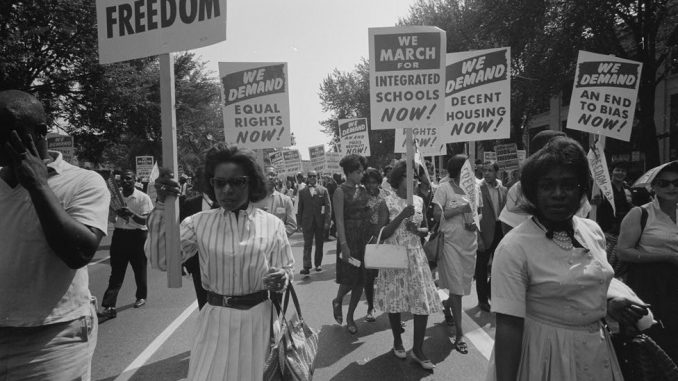
The Civil Rights Movement of the 1950s through the 1970s was one of the most significant social movements in U.S. history. It included millions of people in its ranks. It was a grass roots movement often organized locally.
It was made up of elementary school children in Selma, Alabama and the elderly, registering a man to vote for the first time, in Lowndes County, Alabama who was over 100 years old. It appealed to the consciences of hundreds of northern white students who participated in the Mississippi Freedom Summer of 1964. A whole generation of local leaders emerged, including people like Robert F. Williams, a machinist from Monroe, North Carolina and women leaders like Rosa Parks, a seamstress from Montgomery, Alabama, and Fannie Lou Hamer, a Mississippi sharecropper.
It was a movement filled with ingenuity and imagination. There was certainly violence and danger but it was also joyful, full of singing and defiant celebration – a festival of the oppressed. Consciousness changed overnight and what started out as an act of conscience quickly mushroomed into a massive social movement made up of thousands of little known incidents. The American apartheid system, in place for hundreds of years, was overturned in a decade of action.
The modern Civil Rights Movement was marked by several well-known events: the 1955 Montgomery Bus Boycott and in 1957, the fight to desegregate Little Rock Central High School in Arkansas. Then, in 1960, a few courageous Black students from North Carolina Agricultural and Technical State University sat in at the segregated Woolworth’s lunch counter in Greensboro, North Carolina. The student movement spread quickly.
Within two weeks there were demonstrations in 15 cities in five southern states. In 1961, the Freedom Rides challenged the federal government to defend the right of all of its citizens to be treated equally while traveling on interstate buses. By September of 1961 there were actions in more than 100 cities in 20 states, and more than 70,000 participated, 3600 got arrested.
The movement spread with voter registration drives and community organizing on multiple issues. In 1963, there were 1,412 demonstrations in just the first three months of the year. And the March on Washington that summer brought one quarter of a million people to the capitol. Millions of people were active in small and larger ways. A generation of activists gained valuable experience and a new movement was born.
College students and other youth were the spark of the movement but it was made up primarily of workers and poor farmers. Members of the Brotherhood of Sleeping Car Porters union were often the backbone of the movement, with their extensive organizing experience. The energy and activism of the Civil Rights Movement contributed to every other important social movement of the 1960s and 1970s in the U.S.. It was a movement that went beyond the U.S., connecting to the struggles all over the world as people fought to liberate themselves from colonialism. Many activists of the Civil Rights Movement helped build the movement against the U.S. war on Viet Nam.
It is important to learn from the struggles of the past. The police killings in Ferguson, Baltimore and other cities around the country show that many of the same problems the Civil Rights Movement confronted continue to exist today. The response in Ferguson and elsewhere shows the same spirit of resistance continues today. It is especially necessary to remember the lessons of the past, for they hold the keys to our future. We should be ready to enter the fights ahead armed with those lessons if we are to take the fights beyond resistance and really change the nature of the society we live in today.
Consciousness can change quickly and social movements can be born. When ordinary people decide to stop being treated as victims and instead to be active fighters on the stage of history extraordinary things can happen.

